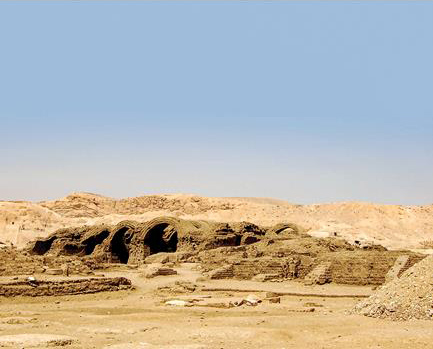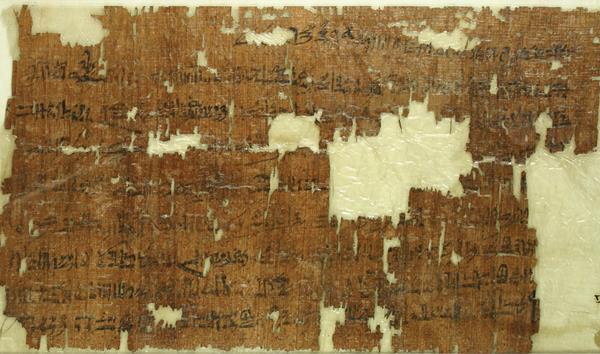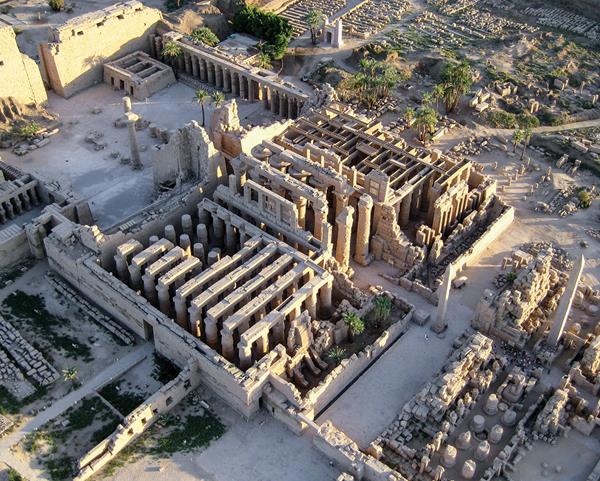https://www.baslibrary.org/biblical-archaeology-review/46/2/6
Brick by Brick
What did the Israelites build in Egypt?

Buildings in ancient Egypt were constructed from either stone or mudbrick. Temples were generally built with stone that was meant to last throughout the ages. Palaces, on the other hand, were built for comfort out of mudbrick, which was cool in the day and warm at night. Each type of construction was considered specialized labor; in other words, people who did one did not do the other.
Contrary to popular perception, the Bible does not claim that the pyramids were built by the Israelites. Most pyramids, and certainly the famous Giza pyramids of the Old Kingdom period, were built hundreds of years before the time of Abraham. Furthermore, archaeological sources reveal that the pyramids were built by native Egyptians who specialized in stone brick construction.

The biblical text describes the Israelite slaves working with mudbricks. After Moses demanded a three-day holiday for the Israelites to go and worship their deity Yahweh, Pharaoh reacted by making the work harder: "You are no longer to give the people straw to make brick as previously; let them go and gather straw for themselves. But the quota of bricks which they were making previously, you shall impose on them; you are not to reduce any of it" (Exodus 5:7–8, NASB).
Pharaoh's speech reveals that making mudbricks also included straw.a Mudbricks were made from Nile alluvium, a conglomerate of clay and sand. The proportion of clay within that alluvium determines much of the properties of the mud. When the content of clay is proportionally high, bricks can be made without the use of straw. When the content of clay is low, as is more typical, straw was added to prevent a brick from falling apart as it dried.1
Papyrus Anastasi IV (12.5–6) expresses one Egyptian soldier's frustration over a lack of skilled labor and supplies: "I am residing at Qenqen-en-ta, without provision, and neither men to make bricks nor straw are in the region." That the Israelites were primarily brickmakers as opposed to builders is apparent when the narrative shifts to the Israelite supervisors. Exodus 5:14-19 repeatedly mentions that the Israelites had a daily quota of bricks that they were required to make.
We know from Papyrus Anastasi III (3.1–2) that the Egyptians set quotas for brickmakers: "Likewise, people are making bricks … they are making their quota of bricks daily." Brickmaking was a labor specialization normative for slaves in ancient Egypt. In the tomb of Rekhmire, dating to the 15th century B.C.E. (Egypt's 18th Dynasty), Levantine Asiatic and Nubian slaves were depicted making bricks.

Without straw, Israelite efforts to meet their quotas were hampered. This gave the Egyptian taskmasters pretense to beat the slaves. Note that in Exodus 5:14 the supervisors were beaten first and then questioned. This interrogation technique—where the suspects were beaten before questioning—was used with the tomb robbery incidents that took place during the reign of Ramesses IX.2

In the Egyptian mind-set, one could guarantee that questions would be answered truthfully only after a severe beating. Papyrus BM 10052 (15.21–23) recorded several of these interrogations, for example, "Examination. The foreigner Ahautinūfer son of Nehk was presented. He said, 'Far be it from me, far be it from me.' He was examined with the stick and found innocent." From Papyrus Amherst (3.6–7), we know these beatings could be severe: "They were examined by beating with a stick, and their feet and hands were twisted."
Exodus 1:11 alludes to the Israelites building Egyptian storage cities: "So they appointed taskmasters over them to afflict them with hard labor. And they built for Pharaoh storage cities, Pithom and Raamses."
These storage cities are not simply coterminous with Pithom and Rameses since these two cities had a variety of buildings that included stone temples. In other words, Pithom and Rameses cannot properly be described as "storage" cities, and thus the verse likely refers to structures within these cities—probably a series of mudbrick depots attached to the temples used to store vast quantities of food.
That the Bible refers to these structures as "cities" instead of merely "buildings" is likely a consequence of the magnitude of these projects. The area that these depots covered sometimes exceeded the area taken up by the temple itself. Examples of storage depots can be found surrounding several mortuary temples, for example, the Ramesseum.

The reason why the temples needed such storage depots was because Egypt had a barter economy that did not use money. Any temple cult only lasted as long as there was food to make offerings and feed priests. Storing food for offerings was essential for a temple to continue operating. Many of the temples in Egypt could not rely upon state support once the king died, and this was especially true of royal mortuary temples.
When the king died, work on most royal building projects and the collection of food for offerings simply stopped; for example, the reliefs on the Processional Colonnade at Luxor Temple started under Tutankhamun were never completed as originally planned because of the death of the king. This is in contrast to the major institutional temples that acted as administrative centers, such as Karnak Temple, which were supported through perpetual land grants and had a constant supply of offerings. The storage cities ensured a constant supply of offerings for a king's mortuary and special interest cults following his death.3
Given these circumstances, Pharaoh's command forcing the Israelites to build these storage depots was more than just slavery. It was a command to make Yahweh's chosen people labor in service to gods other than Yahweh.
-- Sent from my Linux system.

No comments:
Post a Comment